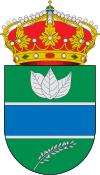La Granja, Spain facts for kids
Quick facts for kids
La Granja
|
|||
|---|---|---|---|
|
Municipality
|
|||
|
|||
| Country | |||
| Autonomous Community | |||
| Province | Cáceres | ||
| Comarca | Ambroz Valley | ||
| Area | |||
| • Total | 14,94 km2 (577 sq mi) | ||
| Elevation
(AMSL)
|
410 m (1,350 ft) | ||
| Population
(2018)
|
|||
| • Total | 335 | ||
| Time zone | UTC+1 (CET) | ||
| • Summer (DST) | UTC+2 (CEST (GMT +2)) | ||
| Postal code |
10711
|
||
| Area code(s) | +34 (Spain) + 927 (Cáceres) | ||
| Website | www.lagranja.es | ||
La Granja, also known as Granja de Granadilla, is a small town in Spain. It is a municipality in the province of Cáceres. This province is part of the Extremadura region in Spain. The town covers an area of about 15 square kilometers (5.8 square miles). In 2011, about 364 people lived there. La Granja is located between two areas called Tierras de Granadilla and Ambroz Valley.
Contents
Nature and Surroundings
La Granja is built on very old land from the Cambrian period. It sits in the valley of the Ambroz River. The town is also at the bottom of the Cruces Altas mountains. These mountains are part of a larger mountain range called the Sistema Central.
The area around La Granja has many holm oak and cork oak trees. You can also find other plants like rockrose, gorse, and lavender. The Ambroz River flows near the town. It forms a wonderful natural swimming spot. This makes La Granja a popular place to visit. In the summer, many town activities happen around this river.
A Look at History
The name La Granja means "the farm." It probably got its name because it was connected to the town of Granadilla. Later, it was linked to the town of Abadía. La Granja was likely a place for farming and supplying goods to these towns. This connection grew after the Reconquista, when the House of Alba family settled and used these lands.
These lands have always been a busy travel route. Many groups have passed through here between the Castilian and Extremaduran plateaus. This also means there have been many battles. You can still see signs of these past times, like old fortresses.
In La Granja, there is a Roman milestone. This is a stone marker from Roman times. It has Latin writing on it. The writing shows that the Romans were present here long ago. It also mentions the Roman emperor who was in charge at that time.
The most important building in La Granja is the Catholic church. Carvings on its walls show when it was built. One carving on the northern side says 1544. Another carving at the base of the church shows the year 1597.
How People Make a Living
In 1847, a writer named Pascual Madoz wrote about La Granja. He said the town grew many crops. These included wheat, rye, barley, chickpeas, and flax. They also produced oil and many vegetables, especially melons and watermelons.
Farmers in La Granja raised different animals. They had sheep, goats, cows, and pigs. People also hunted small game. They caught fish like tench in the lagoons and other fish in the river.
Madoz also wrote about the town's businesses. La Granja had three flour mills and one oil mill. There were six looms for making linen cloth. The town also had a factory that made tiles. People exported some pepper, cattle, and wool from La Granja.
Today, the economy in La Granja is not as strong as it once was. This is true for many villages in the area. Most people (60%) work in farming and raising animals. Raising livestock is the most important part of the economy. Tourism is also becoming more important for the town.
Getting Around
La Granja is located on the EX-205 road. This is an important regional road. It connects the town of Hervás with Portugal. It also links the main rural areas in the northwest of the province.
The Ruta de la Plata Highway is very close. Its smaller road, N-630, is only 1 kilometer (about half a mile) east of La Granja. This makes it easy to get to and from the town. To the north of the village, there is a country road. This road leads directly to Abadía.
Celebrations and Festivals
All the local festivals in La Granja have a Christian religious background. Here are some of the main ones:
- Saint Sebastian or "Los Mártiles": This festival is celebrated on January 20th.
- Carnival: The date for Carnival changes each year. It usually happens between February and March.
- La Romería (the Pilgrimage): This event takes place on the last Saturday of April. It has been celebrated since the early 2000s.
- Saint Anthony ("San Antonio"): This festival is celebrated on June 13th. During a parade with a statue of the saint, people make offerings. These offerings are then sold to the local people.
- Saint Mary Magdalene: This is the biggest and most important festival in La Granja. The main day of celebration is July 22nd.
- The Christ of Peace: This celebration happens on the last Saturday of August.
See also
 In Spanish: La Granja (Cáceres) para niños
In Spanish: La Granja (Cáceres) para niños




